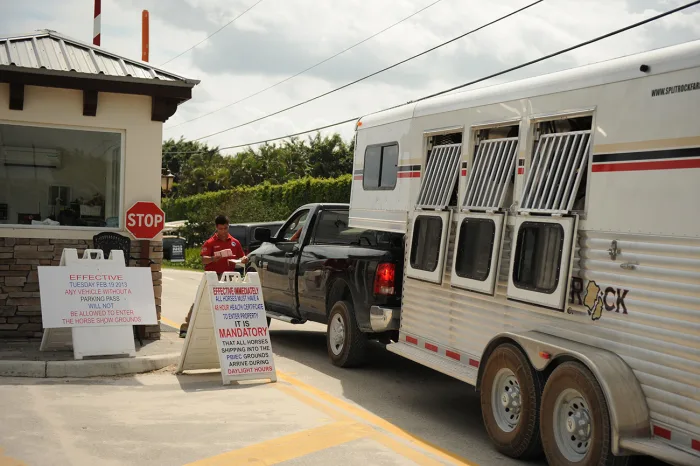In the week since a first case of highly infectious vesicular stomatitis was reported in San Diego County, California, the virus has now been confirmed at eight “equine premises,” and is suspected at 11 more in the state. In response, the U.S. Equestrian Federation has instituted new biosecurity protocols for competitions in affected areas and scheduled a webinar to share information on the disease with its members.
The first, or “index,” case of vesicular stomatitis New Jersey virus (VSNJV) was reported May 17 in an 11-year-old Quarter Horse mare at a barn in San Diego County. The following day, three more premises were confirmed with the virus as well. All horses were confirmed based on compatible clinical signs, including oral lesions, and real-time RT-PCR detection for VSNJV, according to an alert from the California Department of Food and Agriculture.
On May 22, CFDA announced four new premises had been confirmed, and 11 more suspected, in both San Diego County and neighboring Riverside County. Two new premises and two suspected ones are in Riverside County, while the remainder are in San Diego County.

Mollie Bailey Photo
Vesicular stomatitis is a viral disease of horses and other animals. Infection results in vesicles (lesions), crusts and ulceration of the lips, muzzle, nose, tongue, ears, sheath, teats and/or coronary band. Transmission is predominantly by black flies, sand flies and biting midges. The virus is in the active lesion, thus animals with active lesions can transmit the virus by direct contact, shared feed/water sources, and other fomites contaminated by infective lesions, vesicular fluid and/or saliva. The lesions are self-limiting and typically resolve within 14 days. Humans can be infected from exposure to this virus and have mild flu-like symptoms.
To date, all cases are horses confirmed with the VSNJV serotype. The agency is asking horse owners to report any suspicious lesions immediately to ensure accurate diagnostic testing and effective implementation of biosecurity protocols. Confirmed positive and suspect premises are quarantined for at least 14 days from the onset of lesions in the last affected animal on the premises.
In response to the outbreak, USEF has created new biosecurity protocols that competitions must institute immediately, or no later than June 1. The organization also issued a statement to members Tuesday, May 23, announcing it will host an informational webinar on the virus and addressing continued showing in California, and allowing California horses to compete elsewhere, with appropriate biosecurity measures. The approach is different to the one taken in response to 2022’s equine herpesvirus-1 outbreak in the state, where competitions were canceled.
“USEF supports continuing competitions in VS-affected states and competitions which include horses from VS-affected states with the implementation of enhanced biosecurity measures,” the statement said. “USEF is working closely with competition management in California and at events with horses traveling in from California to implement strict health protocols and veterinarian examination prior to admission to the horse show grounds.”
ADVERTISEMENT
The new measures include veterinary examination of horses from outbreak-affected states at their time of arrival on competition grounds. Horses showing symptoms of vesicular stomatitis upon arrival, such as the presence of vesicles, will be prohibited from entering the venue. Then while onsite, these horses will be required to have twice-daily temperature recording and daily monitoring for vesicles. Any horse with a temperature over 101.5 degrees and/or vesicles will be immediately reported to competition management and isolated until a state animal official coordinates response and movement of the horse off the premises, USEF officials said.
“This is the first virus outbreak in California that impacts competitions since EHV-1 and while the biosecurity protocols previously put in place are important, these new USEF biosecurity requirements are specific to this vesicular stomatitis outbreak,” USEF spokeswoman Vicki Lowell said in an email.
“Each disease presents different risk factors for introduction and spread,” she added. “For example, this vesicular virus is self-limiting with lesions healing within 14 days whereas herpesvirus has the potential to be fatal. VS is transmitted by flies thus vector control also plays a significant role in prevention and control.”
USEF created a new senior staff veterinarian position dedicated to equine health and biosecurity to be a resource for competition management and membership and will work with industry stakeholders, including state veterinarians and affiliates, to jointly protect the equid population.
As part of that effort, USEF is planning a webinar, “Vesicular Stomatitis: What You Need To Know,” hosted by Dr. Katie Flynn, the USEF equine health and biosecurity veterinarian, and Dr. Angela Pelzel McCluskey, an equine epidemiologist with the U.S. Department of Agriculture. Pelzel will provide an overview of vesicular stomatitis and an update on the current outbreak, as well as share her perspective from managing numerous previous outbreaks. Flynn will cover prevention measures for home barns and biosecurity measures being implemented in outbreak-affected states.
The webinar will take place at 4 p.m. Eastern Daylight Time on May 31, and registration is required.
More information on vesicular stomatitis is available on the USDA website. Visit the CFDA website for the latest updates on the outbreak.














